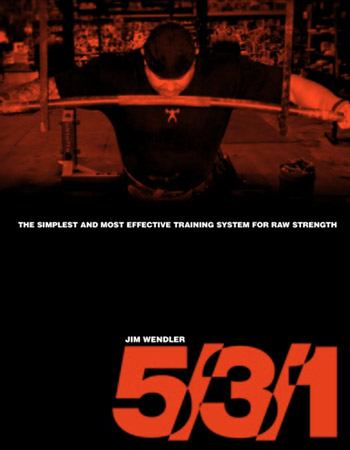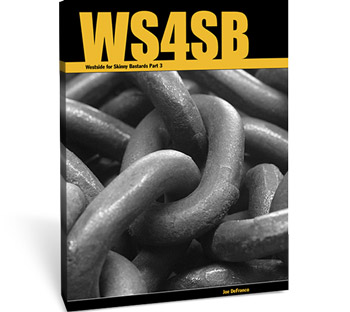
Jim Wendler’s 5/3/1 program and Joe DeFranco’s Westside for Skinny Bastards (WSFSB) have become wildly successful, and I couldn’t be happier to see this. For awhile there, things were getting a little over the top in the strength and conditioning world. Some gurus (usually with a vested financial interest) were using all this new fangled terminology and coming up with bizarre programming recommendations just to differentiate themselves and put their own stamp on things. For a guy like me who grew up reading MILO and the writings of Ken Leistner, John McCallum, and Peary Rader, all this stuff was a bit laughable. Sure, as a fitness professional, long time trainee, and gym owner, I understood all of it, but I couldn‘t imagine being a beginning trainee with no background or experience and trying to implement some of this stuff.
Why are programs like 5/3/1, WSFSB, and others like the Bill Starr inspired 5 X 5 program so popular? They are simple (although not easy mind you), easily understood, and easily applied. Beyond that, they’re extremely effective. Basic set, rep, and progressive resistance protocols and programs are back “en vogue,” and in my opinion, they should have never fallen out of favor to begin with.
The problem with many beginner and intermediate trainees is they tend to use training methods, techniques, and protocols that are entirely too advanced for their existing level of strength and fitness. While cluster training, wave loading, undulating and conjugate periodization schemes, Sheiko, circa max cycles, variable resistance, accommodating resistance, and others have all proven to be extremely valuable and result producing for people who are already strong, these methods are generally unnecessary and potentially detrimental for the beginner to intermediate trainee. Trainees at this level simply don’t need to use these techniques. They don’t know how to apply them, and they often do nothing more than complicate training.
If you can’t perform a 1.5 times your body weight raw barbell bench press or chin-up, press your body weight overhead in the standing barbell press, perform 15–20 full range inverted rows (I like using blast straps) with the feet elevated, perform a twice your body weight raw squat on to a 12–16-inch box, or pull 2.5 times your body weight off the floor, you don’t need advanced or “cutting edge” training techniques. Most guys who think of themselves as “advanced” and beyond basic training protocols usually can’t perform even half of the lifts I just described.
If you can achieve all the aforementioned goals, you’re going to look like you lift weights, you’ll look better than 99 percent of the people walking around on the street, and you might have a better chance of getting laid somewhere else besides the morgue. If someone wants to achieve all of the goals from the basic exercises discussed above, there is good news—consistent application of basic progressive set/rep protocols like those found in 5/3/1, WSFSB, and other programs will get you there. You absolutely don’t need anything fancy or advanced in terms of programming. Simple programs and protocols will deliver great results provided you understand how to perform the exercises properly and in the proper alignment and are willing to bust your ass and actually “go after” each exercise with the utmost focus and intensity.
Ok, with all of the above being said, I also want to throw out some of the basic set, rep, and loading protocols that I use personally and with my clients. Nothing presented below is revolutionary, mind you, but as we’ve established already, “revolutionary” isn’t needed to get most people a physique and level of strength they can be proud of.
The “one half your rep max + 1” protocol
This works well using 6–12 rep max (RM) loads (about 70–85 percent of a 1RM) on any basic, multiple joint exercise. I like these protocols because the loads are heavy enough to increase base strength, but there is also enough volume in there for “functional hypertrophy” or whatever people are calling it nowadays (yawn).
In a nutshell and for simplicity’s sake, take your current 12RM and perform 4–5 sets of 7 reps (that’s half—6—of your 12 RM plus 1). Rest about 2–3 minutes between sets. If you’re using a 10RM load, do 4–5 sets of 6 (one half of your 10 RM is 5 plus 1). 8RM? Do 4–5 sets of 5. You get the picture.
If you complete at least 4 sets of your goal reps, add 2–5 lbs for the next workout (maybe 5–10 for squats and dead variations). You can continue on like this workout to workout, or you can try something like this:
Week 1: 4–5 X 7 using a 12RM
Week 2: 4–5 X 6 using 6% more weight than week 1 (about a 10RM)
Week 3: 4–5 X 5 using 6% more weight than week 2 (about an 8RM)
Week 4: 4–5 X 4 using 6% more weight than week 3 (about a 6RM)
From here, you could continue on and hit 4–5 sets of doubles at a 4RM (again about 6 percent more than week 4), go into multiple singles for maybe 6–8 at 90 percent of a 1RM, or deload before starting a new cycle.
Ascending percentage pyramid
The first time I looked at Jim Wendler’s 5/3/1 workouts, it brought back nostalgic memories of training for basketball in my high school weight room 15 years ago. Our strength coach used to have us perform the “Husker” bench press and squat protocol. He claimed this was what legendary Nebraska strength coach, Boyd Epley, was using with the Cornhuskers. Whether or not that was true is besides the point, but as a teenage jock meathead who would do anything else my strength coach wanted as long as I got to bench and squat heavy for multiple sets, I thought it was pretty cool that I was using the same training techniques as “big time” Division 1 athletes.
The “Husker Power” protocol consisted of:
65% of 1RM X 5 reps
70% of 1RM X 5 reps
75% of 1RM X 5 reps
80% of 1RM X 5 reps plus as many as we could get if we had more in us
2:00 between sets
Back in those days, if we completed all 4 sets of 5 reps, we got to estimate our 1RM 5 lbs higher, and we would adjust the percentages accordingly for the next workout. I still remember the day as a 17-year-old junior that I completed the 300-lb “Husker” bench press protocol. As Ron Burgundy would say, I thought I was “kind of a big deal.”
I still use the “Husker” protocol to this day in my own training and when training clients. I’ve also morphed it a bit and have come up with some other versions:
70% X 4
75% X 4
80% X 4
85% X 4
or
75% X 3
80% X 3
85% X 3
90% X 3
I also use the original protocol, but I keep the weights the same for the first 3 sets and only add weight to the top set from workout to workout. There are many different ways you can go about it, but the keys are to be progressive and challenge yourself over time. As you can see, there are a lot of similarities to Jim’s 5/3/1 and also to the good ole’ 5 X 5 type protocols.
Multiple singles
I mentioned this above. This is another great, basic, strength building protocol popularized by Tony Gentilcore and Eric Cressey of Cressey Performance in Massachusetts. I first came across this approach in an article Tony wrote years back titled, “The Rule of 90%.” My application of this is to simply hit 4–8 single rep sets at 90 percent of a 1RM or above. It’s really simple and straight forward, but if applied progressively, it works very well. Most beginner and intermediate trainees spend far too much time training in the 70–80 percent of their max strength range, which will certainly deliver results but only to a point. Eventually, to continue progressing, they need exposure to truly heavy loads. This type of approach is also obviously similar to the ME work advocated on EliteFTS.com and by Louie Simmons.
Many people ask me how many exercises they should use with these protocols for a given workout. I think you should pick one “indicator” or main movement for each workout and use these types of protocols only with that movement. Trying to use them with every exercise in your routine is asinine and overkill. You’d be at the gym half the day. After the main movement, use the repetition method with the rest of your exercises however you see fit.
So there you go. Plenty of basic, easily applied progressive set and rep protocols that a beginner or intermediate trainee can implement. Remember, you can get pretty strong and jacked with a basic approach if you put forth the consistency and effort and strive to progress. Unless you or those you coach are already above the intermediate level, don’t try to overcomplicate things.
P. J. Striet is the owner of FORCE Fitness & Performance LLC, a private fitness training and sports performance training facility in Cincinnati, Ohio. He also serves as the fitness correspondent for 700 WLW radio, one of the largest radio stations in the United States. You can visit his website at www.cincinnatifitnesstrainer.com, his blog at www.personaltrainerscincinnati.com, his YouTube page at www.youtube.com/ironstriet, or friend him up on Twitter at www.twitter.com/pjstriet.
Elite Fitness Systems strives to be a recognized leader in the strength training industry by providing the highest quality strength training products and services while providing the highest level of customer service in the industry. For the best training equipment, information, and accessories, visit us at www.EliteFTS.com.










